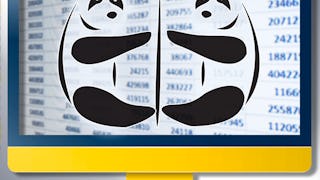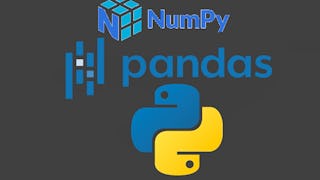How can you effectively use Python to clean, sort, and store data? What are the benefits of using the Pandas library for data science? What best practices can data scientists leverage to better work with multiple types of datasets? In the third course of Data Science Python Foundations Specialization from Duke University, Python users will learn about how Pandas — a common library in Python used for data science — can ease their workflow.
通过 Coursera Plus 解锁访问 10,000 多门课程。开始 7 天免费试用。


Pandas for Data Science
2,663 人已注册
包含在 中
您将学到什么
How and when to leverage the Pandas library for your data science projects
Best practices for cleaning, manipulating, and optimizing data with Pandas
您将获得的技能
要了解的详细信息

添加到您的领英档案
9 项作业
了解顶级公司的员工如何掌握热门技能

积累特定领域的专业知识
- 向行业专家学习新概念
- 获得对主题或工具的基础理解
- 通过实践项目培养工作相关技能
- 获得可共享的职业证书

该课程共有4个模块
This module, you will learn how to read data from files into your python program, and write that corresponding data to a file. We’ll be working primarily with string-type data in this unit and will give special attention to the way that python handles strings. Additionally we’ll go over some basic debugging in python using exception traces, and you’ll leverage these to create your own python program that is capable of reading and writing to a file.
涵盖的内容
5个视频8篇阅读材料3个作业3个编程作业
This module, you’ll learn how to begin to utilize Pandas, one of the most commonly used libraries in Data Science with python. Pandas is predominantly used for working with tabular data. By the end of this module you’ll be able to identify the hallmarks and quirks of working with tabular data, describe the benefits and limitations of using Pandas, and be able to perform some basic data manipulation techniques in Pandas.
涵盖的内容
1个视频9篇阅读材料2个作业3个非评分实验室
This Module, you will learn how to perform basic file operations in Pandas, as well as how to clean up large datasets. You’ll learn to read and write from common tabular file formats, and Pandas-specific intricacies for working with that data. Additionally, you’ll learn best practices for cleaning your data.
涵盖的内容
1个视频13篇阅读材料3个作业4个非评分实验室
This module you will learn how to combine datasets from different sources. Pandas has different methods of combining data depending on your preferred outcome, and you’ll be able to differentiate between when to use each kind. Additionally, we’ll go over computationally efficient ways of querying your data, which, while similar to selecting data via subsetting in its outcomes, has a distinct set of advantages.
涵盖的内容
1个视频12篇阅读材料1个作业5个非评分实验室
获得职业证书
将此证书添加到您的 LinkedIn 个人资料、简历或履历中。在社交媒体和绩效考核中分享。
从 Data Analysis 浏览更多内容
 状态:免费试用
状态:免费试用University of Michigan
人们为什么选择 Coursera 来帮助自己实现职业发展




学生评论
12 条评论
- 5 stars
61.53%
- 4 stars
23.07%
- 3 stars
0%
- 2 stars
7.69%
- 1 star
7.69%
显示 3/12 个
已于 Nov 26, 2025审阅
I really like the content of this course. It covered all the basics for Data Science and I think it set me up to be able to apply it to my workday.
常见问题
To access the course materials, assignments and to earn a Certificate, you will need to purchase the Certificate experience when you enroll in a course. You can try a Free Trial instead, or apply for Financial Aid. The course may offer 'Full Course, No Certificate' instead. This option lets you see all course materials, submit required assessments, and get a final grade. This also means that you will not be able to purchase a Certificate experience.
When you enroll in the course, you get access to all of the courses in the Specialization, and you earn a certificate when you complete the work. Your electronic Certificate will be added to your Accomplishments page - from there, you can print your Certificate or add it to your LinkedIn profile.
Yes. In select learning programs, you can apply for financial aid or a scholarship if you can’t afford the enrollment fee. If fin aid or scholarship is available for your learning program selection, you’ll find a link to apply on the description page.
更多问题
提供助学金,










